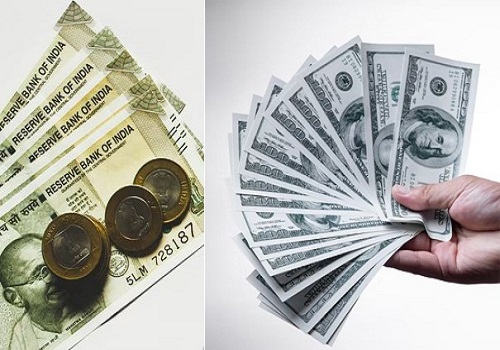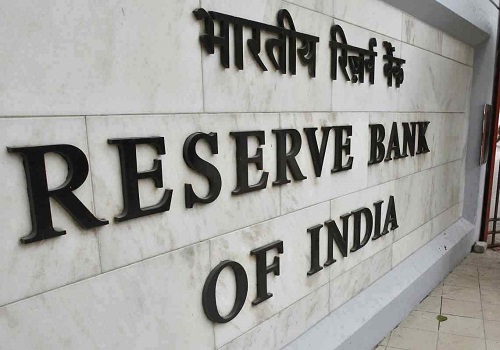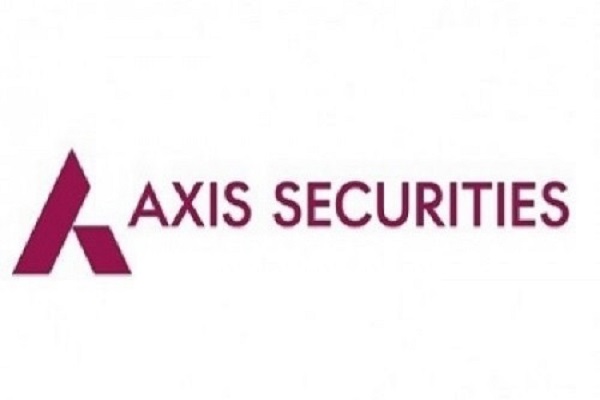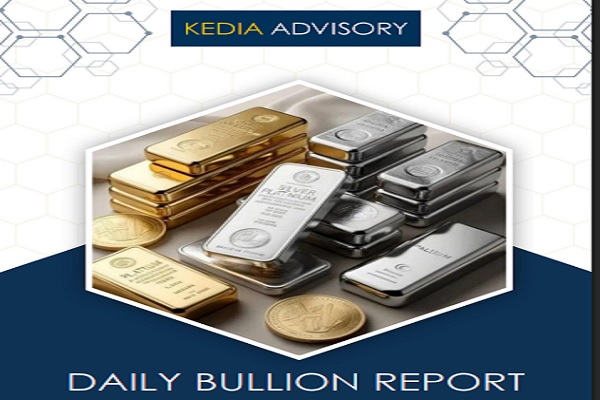Aluminium trading range for the day is 230-239 - Kedia Advisory

Gold
Gold prices rose by 0.67% yesterday, settling at 71970, driven by a softer-than-expected US inflation report that bolstered expectations of lower interest rates by the Federal Reserve. US annual headline inflation unexpectedly eased to 3.3% in May, with the core gauge also moderating to 3.4%, signaling a potential easing in inflationary pressures. This data prompted market speculation that the Fed might implement multiple rate cuts this year, reducing the opportunity cost of holding non-yield-bearing assets like gold and boosting precious metal prices. The Fed's decision to maintain the funds rate at 5.25%-5.5%, despite the dovish outlook, included projections for a single 25bps rate cut in 2024, a revision from earlier forecasts of potentially more aggressive cuts. The cautious stance was underpinned by revised inflation expectations, despite the recent moderation in consumer price increases. In China, gold imports via Hong Kong declined sharply by 38% in April compared to March, highlighting reduced demand in the world's largest gold consumer. This shift contrasts with earlier strong consumption patterns in the first quarter, driven by a nearly 6% year-on-year rise in gold consumption according to the China Gold Association. Indian gold markets continued to trade at a discount for the fifth consecutive week, reflecting subdued domestic demand conditions. Meanwhile, China's central bank paused its 18-month-long gold buying spree in May, coinciding with record-high spot gold prices, after accumulating significant reserves since late 2022. Technically, the gold market saw short covering as evidenced by a 0.14% drop in open interest, settling at 15196 contracts. Prices surged by 480 rupees, indicating renewed buying interest. Immediate support for gold is identified at 71540, with potential downside to 71105. Resistance is anticipated at 72290, and a breakout above this level could propel prices toward 72605.
Trading Ideas:
* Gold trading range for the day is 71105-72605.
* Gold rose after a softer-than-expected US inflation data.
* Fed kept the funds rate unchanged but dot-plot projections showed a sole 25bps rate cut this year
* US annual headline inflation unexpectedly eased to 3.3% in May.
Silver
Silver prices surged yesterday, settling up by 2.01% at 90,445, driven by a surprisingly soft US consumer inflation report that heightened expectations of a potential interest rate cut in 2024. The Federal Reserve's decision to maintain the funds rate unchanged at 5.25%-5.5% but revise its dot-plot projections to include a single 25 basis points rate cut this year, down from earlier expectations of more aggressive cuts in subsequent years, influenced market sentiment significantly. Despite the hawkish signals with upward revisions for inflation, the core consumer price inflation rate in the US eased to a three-year low of 3.4% in May 2024, lower than market forecasts. Silver's bullish trend was further supported by robust demand from India, the world's largest silver consumer, where imports in the first four months of 2024 exceeded the total for all of 2023. This surge in imports, driven by demand from the solar panel industry and investor interest, has buoyed global prices, which are near their highest levels in over a decade. India's strategic imports from the UAE, leveraging lower import duties, contributed significantly to this trend. Technically, the silver market witnessed short covering as indicated by a 3.01% drop in open interest alongside a substantial price increase of 1,782 rupees. Currently, silver is finding support at 89,170, with potential downside targets at 87,895. On the upside, resistance levels are identified at 91,455, and a breakout above this level could propel prices towards 92,465. Investors and traders will closely monitor further developments in US economic indicators and Federal Reserve policy announcements for cues on future market direction, particularly regarding interest rates and inflation expectations.
Trading Ideas:
* Silver trading range for the day is 87895-92465.
* Silver rose after surprisingly soft U.S. consumer inflation report.
* The annual core consumer price inflation rate in US eased to an over three-year low of 3.4% in May 2024.
* The annual inflation rate in the US unexpectedly slowed to 3.3% in May 2024, the lowest in three months.
Crude oil
Crude oil prices edged up by 0.78% yesterday, settling at 6577, driven by optimism surrounding increased future demand and tightening supply conditions anticipated later in the year. The International Energy Agency (IEA) projected that global oil demand will peak by 2029 and begin to decline thereafter, while supply capacity is expected to outpace demand significantly by the end of the decade. The IEA's forecast of supply capacity reaching nearly 114 million barrels per day by 2030, surpassing projected demand by 8 million barrels per day, underscores a potential surplus in the oil market in the coming years. However, in the short term, the IEA revised down its 2024 oil demand growth forecast slightly to 960,000 barrels per day, citing sluggish consumption in developed countries impacted by economic conditions and increasing adoption of green energy alternatives. Despite this, 2025 is expected to see a rebound with an anticipated growth of 1 million barrels per day. In the United States, the latest EIA Petroleum Status Report revealed a notable increase in crude oil stocks by 3.730 million barrels for the week ending June 7, 2024, contrary to market expectations of a decline. Gasoline stocks also surged by 2.566 million barrels, exceeding forecasts, while distillate stockpiles rose by 0.881 million barrels, further indicating ample supply in the market. Notably, crude stocks at the Cushing, Oklahoma delivery hub declined by 1.593 million barrels, reversing a previous build. Technically, the crude oil market witnessed short covering, evidenced by a 9.93% drop in open interest to settle at 6375 contracts, despite prices rising by 51 rupees. Currently, crude oil is supported at 6516, with potential downside to 6454. Resistance is likely at 6631, with a breakout above this level potentially testing 6684.
Trading Ideas:
* Crudeoil trading range for the day is 6454-6684.
* Crude oil gains on hopes of increased demand, and tighter supply conditions later in the year.
* Stocks of crude oil in the United States rose by 3.730 million barrels
* IEA trimmed its 2024 oil demand growth forecast by 100,000 bpd to 960,000 bpd citing sluggish consumption in developed countries.
Natural gas
Natural gas prices experienced a decline yesterday, settling down by 1.44% at 252.8, primarily influenced by revised demand forecasts indicating lower expected consumption over the next two weeks. This adjustment in demand outlook was compounded by expectations of increased supply as the completion of the Mountain Valley Pipeline nears, alongside a significant oversupply of gas currently in storage. Despite these bearish factors, a recent drop in gas output and ongoing hot weather across the Lower 48 states supported prices and limited the downside. The market also reacted to news from the U.S. National Hurricane Center regarding a tropical disturbance in the Gulf of Mexico, which could potentially develop into a cyclone and affect gas production and distribution along the Gulf Coast, adding an element of uncertainty to future supply dynamics. Gas output in the Lower 48 states has seen a decline to a 20-week low of 95.2 bcfd, down from a monthly record of 105.5 bcfd in December 2023. This reduction in output, combined with sustained above-average temperatures expected through June 26 according to meteorological forecasts, provided some support to natural gas prices. In terms of storage, Despite these injections, total gas in storage stands at 2,893 Bcf, well above last year's levels and significantly exceeding the five-year average, indicating ample supply in the market. Technically, the natural gas market saw long liquidation as evidenced by a 1.66% drop in open interest alongside a price decline of 3.7 rupees. Currently, natural gas is finding support at 248.4, with potential downside targets at 244. On the upside, resistance levels are identified at 259.2, and a breakout above this level could lead prices towards 265.6.
Trading Ideas:
* Naturalgas trading range for the day is 244-265.6.
* Natural gas dropped amid forecasts for less demand over the next two weeks than previously expected.
* The U.S. National Hurricane Center predicts a 20% chance of a tropical disturbance in the Gulf of Mexico becoming a cyclone in the next seven days.
* Gas output in Lower 48 U.S. states fell to an average of 97.8 billion cubic feet per day in June, down from 98.1 bcfd in May.
Copper
Copper prices rose by 1.05% yesterday, settling at 867.2, primarily driven by a weaker US dollar following softer-than-expected US inflation data. This outcome bolstered expectations that the Federal Reserve might implement interest rate cuts sooner than anticipated, thereby weakening the dollar and supporting commodity prices including copper. Despite the price increase, concerns over high inventory levels persisted, with copper stockpiles remaining at a four-year high of 336,964 tonnes in Shanghai Futures Exchange (ShFE) warehouses. Additionally, approximately 20.8% of global copper smelting capacity was inactive in May due to maintenance shutdowns, slightly higher than the previous year. These factors indicated a subdued buying appetite in the market, despite speculative bets on potential supply shortages driving prices up by 13% year-to-date. The copper market also saw significant developments in production and consumption dynamics. Codelco, the Chilean state-run miner, successfully averted a strike at its Andina mine by reaching a collective contract agreement with the worker's union. This agreement helped stabilize supply concerns from one of the world's largest copper producers. Internationally, the refined copper market showed a surplus of 125,000 metric tons in March, a decrease from February's surplus of 191,000 metric tons, according to the International Copper Study Group (ICSG). This data highlighted a balance between production and consumption, influenced by global economic conditions and trade dynamics. In China, despite weak physical consumption, unwrought copper imports surged by 15.8% year-on-year in May, surpassing market expectations. Technically, the copper market witnessed short covering, indicated by an 11.17% drop in open interest, coupled with a price increase of 9.05 rupees. Copper is currently supported at 858.4, with potential downside to 849.7. Resistance is anticipated at 876.4, and a breakout above this level could lead prices to test 885.7.
Trading Ideas:
* Copper trading range for the day is 849.7-885.7.
* Copper prices bounced as the dollar tumbled after cooler-than-expected U.S. inflation data
* About a fifth of global copper smelting capacity was suspended in May, mostly for maintenance.
* Copper inventory remained at a four-year high of 336,964 tonnes in warehouses monitored by SHFE.
Zinc
Zinc prices surged by 3.07% yesterday, settling at 260.2, driven by a weakening US dollar following softer-than-expected US inflation data. The report showed that consumer prices in May rose less than economists had forecast, fueling expectations that the Federal Reserve might initiate interest rate cuts sooner than anticipated, potentially bolstering commodity demand. In addition to domestic factors, global zinc markets were influenced by developments in China, the world's largest consumer of metals. China's manufacturing PMI for May disappointed market expectations, signaling a contraction in manufacturing activity. This dampened demand sentiment for industrial metals like zinc. However, Chinese refined zinc output in April showed a month-on-month decline, contributing to a slight tightening in supply dynamics. The global zinc market also saw a reduction in surplus, dropping to 52,300 metric tons in March from 66,800 tons in February, according to data from the International Lead and Zinc Study Group (ILZSG). The first quarter of the year recorded a surplus of 144,000 tons, down from 201,000 tons in the same period last year. This reduction in surplus suggests a modest improvement in market balance, which typically supports prices. Technically, the zinc market experienced short covering as indicated by a significant drop of 22.13% in open interest, coupled with a price increase of 7.75 rupees. Currently, zinc is finding support at 255.2, with potential downside levels around 250.2. On the upside, resistance levels are noted at 263.4, and a break above this level could propel prices towards 266.6.
Trading Ideas:
* Zinc trading range for the day is 250.2-266.6.
* Zinc gains as dollar tumbled after data showed that consumer prices in May rose less than expected.
* China’s manufacturing PMI came in below market expectations, pointing to a contraction in manufacturing activity
* China's refined zinc output was 504,600 mt, a month-on-month decrease of 20,900 mt or 3.99%
aluminium
Yesterday, aluminium prices surged by 1.07%, settling at 235.5, driven by short covering and concerns over supply tightness in the global market. The London Metal Exchange (LME) cash aluminium contract traded at a significant discount of $62.44 per ton to the three-month contract, the widest since August 2007. This divergence was spurred by a sharp increase in inventories, which more than doubled to 1.1 million tons within a month, signaling unusual market dynamics amidst supply disruptions. The US dollar strengthened following robust job creation data, suggesting potential delays in the Federal Reserve's anticipated easing cycle, which typically supports commodity prices. Recent disruptions in alumina supply further fueled market concerns. Reduced output from China and force majeure declarations by mining giant Rio Tinto on alumina shipments from Australian refineries exacerbated shortages of this critical aluminium precursor. This supply squeeze contributed to bullish sentiment among market participants. Amidst these supply constraints, one global aluminium producer offered Japanese buyers a substantial premium of $175 per metric ton for July-September shipments, marking an 18% to 21% increase on a quarterly basis. According to the International Aluminium Institute (IAI), global primary aluminium output in April grew by 3.3% year-on-year, reaching 5.898 million tonnes. Notably, China's unwrought aluminium imports surged by 72.1% in April compared to the previous year, totaling 380,000 metric tons. Import volumes in the first four months of the year soared by 86.6%, highlighting robust international demand amidst supply challenges. Technically, aluminium witnessed short covering as evidenced by a 6.39% drop in open interest alongside a modest price increase of 2.5 rupees. Key support levels for aluminium are identified at 232.7, with potential downside towards 230. Resistance is anticipated at 237.2, and a breach above could test higher levels around 239.
Trading Ideas:
* Aluminium trading range for the day is 230-239.
* Aluminium prices rose amid short covering and driven by supply tightness.
* The discount of the LME cash aluminium contract to the three-month contract expanded to $62.44 a ton
* Global primary aluminium output in April rose 3.3% year on year to 5.898 million tonnes
Cottoncandy
Yesterday, Cottoncandy prices closed lower by -0.21% at 56,220, reflecting concerns over sluggish milling demand amidst muted global yarn demand. Despite these challenges, the downside was limited as India continued to experience strong demand for its cotton from countries like Bangladesh and Vietnam. Prospects of a potentially better crop in countries such as Australia added to the market dynamics. The International Cotton Advisory Committee (ICAC) has projected growth in cotton-producing areas, production, consumption, and trade for the upcoming season, 2024-25. In India, cotton stocks are anticipated to decrease by nearly 31% in the 2023/24 marketing year, reaching their lowest levels in over three decades due to lower production and increased domestic consumption. This reduction in stocks is expected to constrain exports from India, the world's second-largest producer, which could support global prices while potentially squeezing margins for local textile companies. For the current season, India is forecasted to produce 30.97 million bales of cotton, slightly lower than the previous year, with consumption expected to rise. Cotton exports from India are projected to increase to 2.20 million bales from 1.55 million bales last year, according to the Cotton Association of India (CAI). Looking ahead to MY 2024/25, India's cotton production is estimated to decline to 25.4 million bales, reflecting a shift in acreage towards higher-return crops like pulses and maize. Technically, the cotton market is currently experiencing selling pressure, indicated by a modest increase of 0.56% in open interest to settle at 360 contracts, alongside a price decline of -120 rupees. Support levels for Cottoncandy are identified at 56,020, with a potential test of 55,810 on a break below. Resistance is anticipated at 56,420, and a breakout above could lead to testing the 56,610 mark.
Trading Ideas:
* Cottoncandy trading range for the day is 55810-56610.
* Cotton dropped as sluggish milling demand is still concerns amid muted demand of yarn
* U.S. ending stocks projected 1.3 million bales above 2023/24 level
* Global supplies in 2024/25 projected to be higher than previous year
* In Rajkot, a major spot market, the price ended at 26705.8 Rupees dropped by -0.3 percent.
Turmeric
Turmeric prices settled slightly higher yesterday, up by 0.08% to 17,842, driven by farmers holding back stocks in anticipation of further price increases. However, the upside was tempered by increased supplies towards the end of the harvesting season. A significant factor influencing the market is the current heat wave across India, which poses a threat to crop yields. The India Meteorological Department has warned of continued heat waves, with rainfall in southern parts of India significantly below normal levels, further exacerbating supply concerns. The Ministry of Agriculture and Farmers’ Welfare's first advance estimate pegs turmeric production for 2023-24 at 10.74 lakh tonnes, down from 11.30 lakh tonnes in the previous year. This reduction in production, coupled with demand destruction due to high prices, has created a dynamic where many are operating on a hand-to-mouth basis. Turmeric exports during April-March 2024 saw a decline of 4.75% to 162,018.50 tonnes compared to the previous year, reflecting lower global demand or competitive pressures. However, March 2024 showed a month-on-month increase in exports, indicating some recovery. Imports, on the other hand, decreased by 12.71% to 14,637.55 tonnes during the same period, suggesting a balanced trade scenario with reduced reliance on imports. In major spot markets like Nizamabad, turmeric prices ended marginally higher at 18,120 rupees, up by 0.05%. In terms of technical analysis, the turmeric market is witnessing fresh buying interest, evident from a 6.71% rise in open interest to settle at 19,240 contracts, while prices rose by 14 rupees. Currently, turmeric is supported at 17,582, with potential downside testing towards 17,324. On the upside, resistance is expected at 18,124, and a breakout above this level could push prices towards 18,408.
Trading Ideas:
* Turmeric trading range for the day is 17324-18408.
* Turmeric settled flat as farmers are holding back stocks in anticipation of a further rise.
* The current heat wave could severely damage the crop yield, further contributing to the supply crunch.
* The Ministry of Agriculture first advance estimate for turmeric production in 2023-24 is estimated at 10.74 lakh tonnes
* In Nizamabad, a major spot market, the price ended at 18120 Rupees gained by 0.05 percent.
Jeera
Jeera prices surged by 2.13% yesterday to settle at 27,515, driven by robust domestic and export demand coupled with tight global supplies. Despite these bullish factors, the upside potential was capped by expectations of higher production in the current season, which could potentially weigh on prices going forward. Farmers holding back stocks in anticipation of better prices also supported the upward momentum in the market. Production estimates for jeera indicate a significant increase of 30% this season, reaching between 8.5 to 9 lakh tonnes, primarily due to expanded cultivation areas in Gujarat and Rajasthan. Gujarat saw a remarkable 104% increase in sowing area, while Rajasthan recorded a 16% rise. This surge in production is part of a broader global trend, with countries like China, Syria, Turkey, and Afghanistan ramping up their cumin output to capitalize on previous high prices. As these new supplies enter the market, downward pressure on prices is expected. In terms of trade dynamics, jeera exports during April-March 2024 declined by 13.53% to 152,189.32 tonnes compared to the previous year, reflecting fluctuating global demand and competitive pricing pressures. However, March 2024 witnessed a notable increase in exports, rising by 198.98% month-on-month, indicating variability in export patterns influenced by market conditions and pricing trends. Technically, the jeera market witnessed fresh buying interest, evidenced by a 4.71% increase in open interest to settle at 3,270 contracts, while prices surged by 575 rupees. Currently, Jeera is supported at 26,960, with potential downside testing towards 26,410. On the upside, resistance levels are anticipated at 27,850, and a breakout above could lead to further gains towards 28,190.
Trading Ideas:
* Jeera trading range for the day is 26410-28190.
* Jeera gains amid robust domestic and export demand besides tight global supplies.
* China's cumin output soared to over 55-60 thousand tons from the previous 28-30 thousand tons.
* Turkey anticipates producing 12-15 thousand tons, while Afghanistan's output could double.
* In Unjha, a major spot market, the price ended at 28074.85 Rupees gained by 0.46 percent.
Views express by all participants are for information & academic purpose only. Kindly read disclaimer before referring below views.























